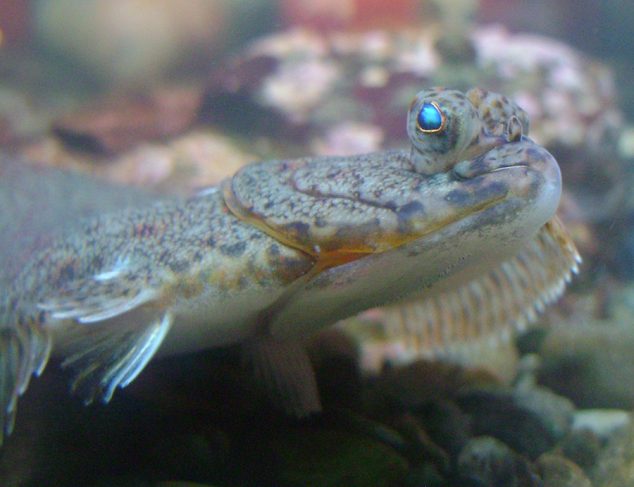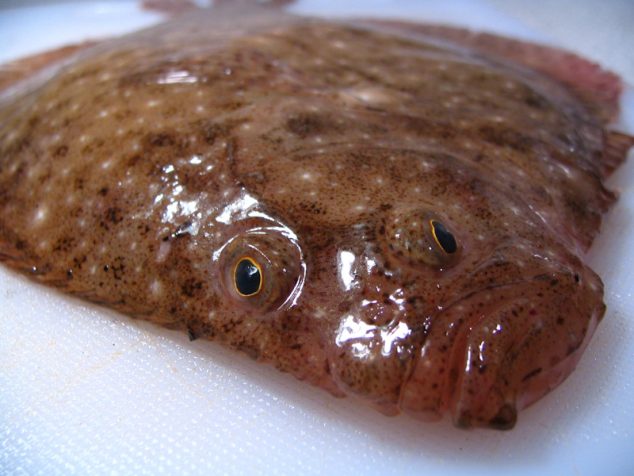Flounder

Species Description
American plaice (or dab) Hippoglossoides platessoides
Winter flounder (blackback flounder or lemon sole) Pseudopleuronectes americanus
Windowpane (sand) flounder Scophthalmus aquosus
Witch flounder (grey sole) Glyptocephalus cynoglossus
Yellowtail flounder Limanda ferruginea
Wild.
Flounders are flat fishes: they lie not on their bellies, but on one side. Their skulls twist as they grow, so that the eye that was originally on the underside migrates around the head, until both eyes come to lie close together on the side facing up, either left or right.
American plaice or dab is a large-mouthed, right-eyed flounder common in deep, sandy or muddy-bottomed waters in the Gulf of Maine and along the Northwest Atlantic continental shelf from southern Labrador to Rhode Island.
Winter flounder is a thick, right-eyed flatfish with dark mottled skin, inhabiting the shallow, muddy bottoms of brackish rivers and estuaries from Labrador to Georgia.
Windowpane flounder is a thin, pale, left-eyed flatfish that lives on the bottom of sandy and muddy bays and estuaries from the Gulf of St. Lawrence to Florida, with concentrations on Georges Bank and the mid-Atlantic. In the Gulf of Maine, most are found in Massachusetts Bay.
Witch flounder is a thin, smooth, right-eyed flatfish found from Labrador to Virginia in deep, muddy-bottomed waters. Generally brown or russet gray.
Yellowtail flounder is a thin, right-eyed flatfish ranging deep, sandy-bottom habitat from Gulf of St. Lawrence to Chesapeake Bay.
Season
Plaice: Year-round.
Winter flounder: Year-round.
Windowpane flounder: Illegal to harvest.
Witch flounder: Year-round.
Yellowtail: Year-round.
Status
American plaice stock in the Gulf of Maine is not overfished nor is overfishing occurring.
Winter flounder stock in the Gulf of Maine has not been assessed, the population level is unknown, and management measures are in place.
Windowpane flounder is illegal to harvest.
Witch flounder in the Gulf of Maine is overfished.
Yellowtail flounder in the Gulf of Maine is not overfished.
Regulatory Authority
Flounders and plaice are part of the Northeast Multispecies (groundfish) fishery managed by the New England Fishery Management Council and NOAA Fisheries.
Harvest Method
Flounder are generally caught by otter trawl and gillnet, also some by hook and line. See the vessel and gear guide for more information.
Recreational Harvest
Minimum sizes:
- American plaice (or dab): 14 inches, no bag limit
- Winter flounder: 12 inches, 8 fish per day per angler
- Witch flounder: 14 inches, no bag limit
- Yellowtail flounder: 13 inches, no bag limit
Note: Windowpane flounder are illegal to harvest.
Health Benefits & Risks
Flounder is a low-fat, low-calorie source of vitamin B12, vitamin D, selenium, and omega-3 fatty acids. Flounder is low in mercury. Windowpane flounder is sensitive to pollution, and in general the presence of healthy flatfishes indicates clean water and sediment.
View the 2021 US Food and Drug Administration’s fish consumption guidelines.
Buying & Preparing
Flounder is a mild, delicate white fish with a fine, flaky texture that lends itself to frying, broiling, baking, or poaching. Its subtle flavor pairs well with lemon, herbs, and light sauces.
Multiple species of flounder are landed in Maine but retail labels often simply say “flounder.” If the species isn’t listed, ask your fishmonger; different types can vary slightly in texture and flavor.
Because of its tenderness, flounder cooks quickly. Try it lightly breaded and pan-fried, or baked with white wine and herbs. It’s also excellent in stuffed or rolled fillet recipes.
Recipes
- Flounder recipes, NOAA Fisheries
- Sheet pan flounder with green goddess dressing, Maine Coast Fishermen’s Association
Certifications & Verifications
Links
- NOAA Fisheries Species Directory


